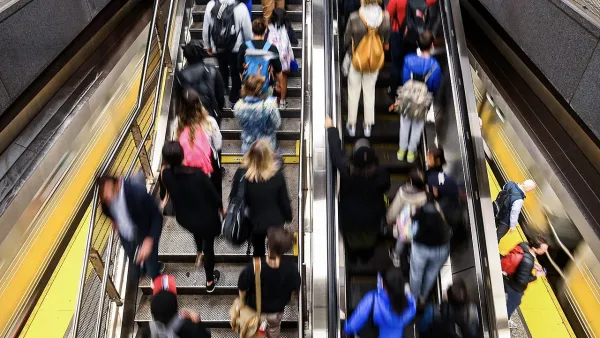Transit authorities often push cuts on the people most dependent on public transit, sometimes called "captive riders." Instead, they focus resources on luring tourists and "choice riders" out of their cars. An article by Samantha Winslow explains.

On one side of town, tourists and young professionals head downtown on light rail: clean, air-conditioned, fast. If there’s a problem with service, the city diverts buses to help.
On the other side of town, workers wait at bus stops. The buses that carry them to work come less and less frequently, thanks to service cuts. Drivers struggle to get through their routes in less time.
Both scenarios are part of a promising trend: transit ridership is at its highest since 1956, with 10.7 million trips in 2013, according to the American Public Transportation Association.
This is despite widespread cuts to bus and rail service—and rising fares. The 2008 economic crisis started the pinch, but federal and local officials have continued to squeeze.
In Pittsburgh, for example, bus riders are still feeling the cuts begun during the crisis, while the city’s seen a boost in light rail, which caters to tourists and people with cars.
In 2011 the transit authority cut its budget by 15 percent, eliminating 29 bus routes. It laid off 180 workers and reduced hours for more. The cuts continued the following year, and the region lost tens of thousands of bus riders. Some switched to cars, if they had one, or carpooling. Others walk now.
“We have whole segments of our community that don’t have any transit at all,” driver Mike Harms said. In neighborhoods where service was slashed, “people have to walk a mile to a bus stop.”
FULL STORY: Transit Irony: The More You Rely on It, the More They Cut

Planetizen Federal Action Tracker
A weekly monitor of how Trump’s orders and actions are impacting planners and planning in America.

Chicago’s Ghost Rails
Just beneath the surface of the modern city lie the remnants of its expansive early 20th-century streetcar system.

Amtrak Cutting Jobs, Funding to High-Speed Rail
The agency plans to cut 10 percent of its workforce and has confirmed it will not fund new high-speed rail projects.

Ohio Forces Data Centers to Prepay for Power
Utilities are calling on states to hold data center operators responsible for new energy demands to prevent leaving consumers on the hook for their bills.

MARTA CEO Steps Down Amid Citizenship Concerns
MARTA’s board announced Thursday that its chief, who is from Canada, is resigning due to questions about his immigration status.

Silicon Valley ‘Bike Superhighway’ Awarded $14M State Grant
A Caltrans grant brings the 10-mile Central Bikeway project connecting Santa Clara and East San Jose closer to fruition.
Urban Design for Planners 1: Software Tools
This six-course series explores essential urban design concepts using open source software and equips planners with the tools they need to participate fully in the urban design process.
Planning for Universal Design
Learn the tools for implementing Universal Design in planning regulations.
Caltrans
City of Fort Worth
Mpact (founded as Rail~Volution)
City of Camden Redevelopment Agency
City of Astoria
City of Portland
City of Laramie





























